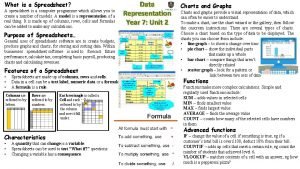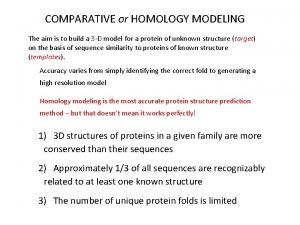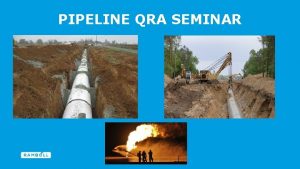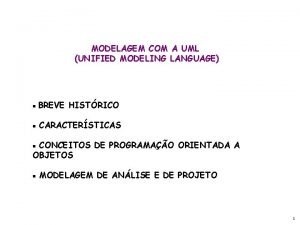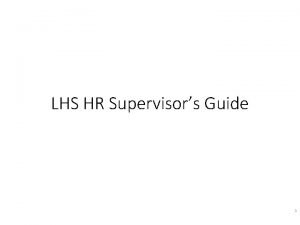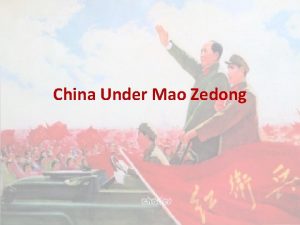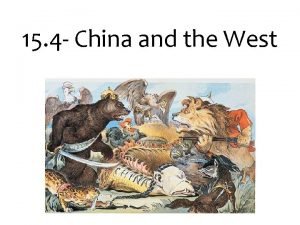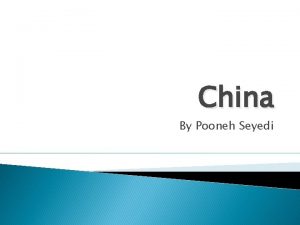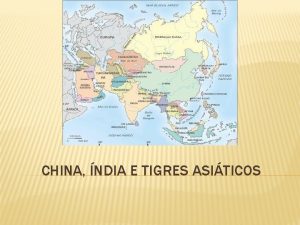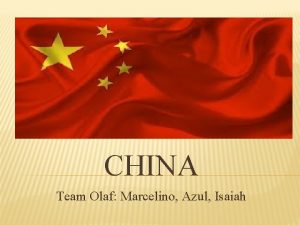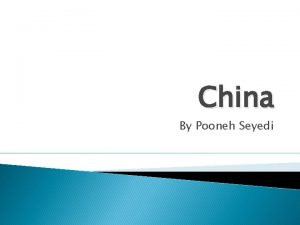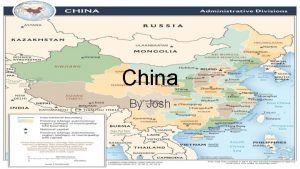GLAMwheat modelling in China Sanai Li Supervisors Prof




















- Slides: 20

GLAM-wheat modelling in China Sanai Li Supervisors: Prof. Tim Wheeler, Dr Andrew Challinor Prof. Julia Slingo, Crops and Climate Group

Outline l l Background GLAM-Wheat model evaluation Impact of temperature on wheat Impact of future climate change on wheat

Background 1 Assessment of regional crop production is critical, especially for China

Background 2 Crop model at the field level l. Complexity of incorporating the spatial variability of input l. High input data requirement l. Climate model output is coarse compared with input to the dynamic crop model This method is difficult to apply at a regional level (Yang. P).

Development of a large area wheat model-GLAM-Wheat GLAM-General Large-Area Model for annual crops Ø Defining the wheat parameter sets Ø Quantifying the impact of temperature on crop Ø Parameterising the CO 2 fertilisation effect

Hadley Centre RCM system-Providing Regional Climates for Impacts Studies - PRECIS Observed Annual Tmean (o. C), 1961 -90 Simulated Annual Tmean (o. C), 1961 -90 Observed Annual Precipitation (mm/day), 1961 -90 Simulated Annual Precipitation (mm/day), 1961 -90 From the first China-UK Collaboration Project

Comparison of wheat yield between observations and simulations at the county level

Correlation between observed and simulated yield at the county/city (70 -129 km) level and field level Significant level Spring wheat Winter wheat

Comparison of simulated and observed wheat yield (kg/ha) at 0. 5 o scale across China (a) Observations (b) Simulations

Difference between observed and simulated mean wheat yield (%) (correlation r= 0. 83, p<0. 001)

Cardinal temperature values for selected annual crops under conditions in which temperature is the only limiting variable

The observed impact of temperature on wheat Tendency of temperature from 1951 to 2001(Ren et al, 2003)

The simulated response of wheat yield (%) to an increase in temperature (o. C) in China T+1 T+2

Wheat yield change (%) for per 1 o. C rise in temperature Methods Location Observations Global (1961 -2002) Yield change(%) -3. 2 to -8. 4 South Asia -2. 6 ± 0. 7 CERES-Wheat Central America -5. 1 ± 1. 8 model Brazil -7. 1 ± 2. 4 GLAM-Wheat model China -4. 6 to -5. 7 Lobell and Field, 2007 Lobell et al. , 2008

Changes in average precipitation (mm day-1) from PRECIS for 2071 to 2099 under the A 2 scenario relative to the baseline (1961 -1990) (b) A 2 DJF (c) A 2 MAM (a) A 2 Annual (d) A 2 JJA (e) A 2 SON

Changes in the annual and summer mean temperature (o. C) (relative to 1961 -1990) for the A 2 and B 2 scenarios during 2071 to 2099. (a) A 2 Annual (b) B 2 Annual (c) A 2 JJA (d) B 2 JJA

The predicted change in the average winter yield during 2072 to 2100 for the A 2 and B 2 scenarios, relative to the baseline (1961 -1990) A 2 without the CO 2 effect B 2 without the CO 2 effect A 2 with the CO 2 effect B 2 with the CO 2 effect

Predicted changes (relative to baseline) in the coefficient of the variation of winter wheat yield for 2072 to 2100 in the North China Plain

Conclusions l The GLAM model is suitable to simulate crop yield at large scales (approximately 100 km) for regional area, county and global studies of the impacts of climate change l Across China, the simulated average wheat yield would reduce by 4. 6 -5. 7% for each 1 o. C rise in mean temperature. l Without the CO 2 effect, wheat yield by 2100 is expected to increase by 20 -50% in the north of the North China plain, and reduce by 1040% in the south. The CO 2 effect tends to offset the negative impact. l The variability of wheat yield is expected to increase due to an increase in climate variability.

Thanks
 Julie brooke cowden
Julie brooke cowden Compliance training for managers
Compliance training for managers Bath county board of supervisors
Bath county board of supervisors Weights of the backpacks of first graders on a school bus.
Weights of the backpacks of first graders on a school bus. Leader safety course module 2 answers
Leader safety course module 2 answers Pa association of township supervisors
Pa association of township supervisors Ergonomics awareness training for supervisors
Ergonomics awareness training for supervisors Danger zones for supervisors
Danger zones for supervisors Tn data and attendance conference
Tn data and attendance conference Pa state association of township supervisors
Pa state association of township supervisors Ergonomics awareness training for supervisors
Ergonomics awareness training for supervisors Tccg ground
Tccg ground Compliance training for managers
Compliance training for managers What is spreadsheet
What is spreadsheet Climate based daylight modelling
Climate based daylight modelling Multi jet modeling
Multi jet modeling Universal modelling language
Universal modelling language Homology modelling steps
Homology modelling steps Modelling madness
Modelling madness Consequence modelling software
Consequence modelling software Relacionamentos uml
Relacionamentos uml













